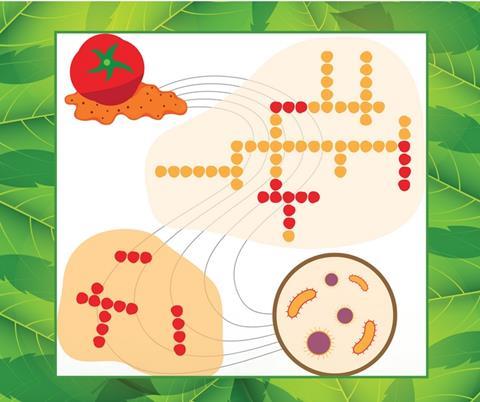Scientists have revealed how it is possible to extract bactericidal mixtures from tomato peels in a short and sustainable process.
In an article published on the cover of ACS Sustainable Chemistry and Engineering, a team of ITQB NOVA and INRAE (France) showed extracts of tomato peel could be processed to obtain mixtures with antimicrobial activity against pathogenic bacteria.

In recent years, agro-industrial residues have been explored for the development of bioplastics, food supplements, and other applications. In Europe alone, nearly 10 million tons of tomato fruit were processed in 2020, generating half a million tons of tomato pomace - residues of peels, stems and seeds.
Fruit peel acts as a barrier against outer damage, pathogen invasion and preventing water loss. The cuticle is the outermost part of the fruit peel and is mainly comprised of cutin. This polymer, a network of molecules, is highly abundant in nature and provides antimicrobial properties to the peel. Due to its easily removable cuticle, the tomato is a key model for studies on cutin.
Portugal is the third biggest processor of tomatoes in Europe and the resulting pomace is usually destined for animal feeding. In this article, a team of scientists led by ITQB NOVA’s PI Cristina Silva Pereira focused on further exploring the potential of tomato pomace as a source of antimicrobial mixtures extracted from cutin, through a fast, simple and sustainable method.
Depending on the processing and cultivation methods, pomaces’ composition can vary significantly (different amounts of seeds, peels and stems). The team studied the extraction process from two tomato pomaces, produced in two different countries. They used a liquid extractant, which allows the recovery of cutin with minor alterations and washes out the remaining components. In addition, this extractant is biodegradable, biocompatible, and can be recycled and reused.
The researchers showed that the extracts could be processed to obtain mixtures with antimicrobial activity against pathogenic bacteria. Both mixtures showed effectiveness against Staphylococcus aureus and Escherichia coli. However, there were some differences in effectiveness against E. coli, depending on the composition of the pomace.
“Many studies have explored the potential of tomato peels as a source of cutin”, says Rita Escórcio, who has been studying the process during her PhD.
“However, they rely on long processes with multiple steps. We have just provided proof of concept that it is possible to use tomato pomace to extract cutin in a fast, simple and green method. The extracts can then be processed to obtain mixtures with antimicrobial properties.”
In the future, these mixtures can be used to provide antimicrobial properties to biomaterials.
“This is an important contribution to the future of circular usage of fruit pomace”, adds Cristina Silva Pereira, head of the in the Applied and Environmental Mycology lab, where Rita is developing her work.
“Further studies are needed to optimize the production of broader bactericidal mixtures from any cutin-rich source. In the future, the goal is to translate this process to the industrial scale and search for methods to make it even greener.”







No comments yet